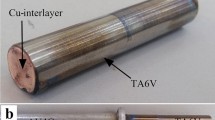Abstract
Increasing demands in industrial applications and simultaneous efforts to provide long-lasting and cost-efficient tools in the injection molding industry lead to the use of metal–ceramic joints with the aim to combine the specific properties of both materials. Due to its high CTE, zirconium oxide (ZrO2) is used for the ceramic part and is joined with the tool steel AISI H11 (1.2343). In this work, suitable joining techniques with a low heat input and therefore a low thermal load are applied and characterized for the production of metal–ceramic composites. The selection of joining techniques is based on the boundary conditions during the injection molding process, in which the composites have to resist the temperature, pressure, as well as shear and tensile loads. Therefore, besides brazing, other joining processes such as gluing, screwing, shrinking, and clamping were analyzed as possible low temperature joining techniques for ceramic-metal-compounds. The best results for the tensile strengths with 90 MPa were achieved by a brazing process, carried out in vacuum with approximately 10−5 mbar, at a temperature of 920 °C for 5 min, using the commercially available brazing filler alloy CB4.













Similar content being viewed by others
References
Fernie, J. A.; Drew, R. A. L.; Knowles, K. M.: “Joining of engineering ceramics”. Int Mater Rev 54 (2009), Nr. 5, p. 283–331
Schwartz M (1990) Ceramic joining, 1st edn. ASM International, Materials Park, Ohio
Nicklas, D.; El Gammal, A.: 2009“Anwendungsbeispiele im Maschinen- und Anlagenbau”. In: Kollenberg, W. (Hrsg.): Technische Keramik: Grundlagen - Werkstoffe - Verfahrenstechnik. 2. Auflage. Vulkan-Verlag, Essen, . – ISBN 978–3–8027–2927–7, Kapitel 5.2, p. 588–605
Nicholas MG (1990) Joining of ceramics. Chapman and Hall, London
Tietz HD (1994) Technische Keramik – Aufbau, Eigenschaften, Herstellung, Bearbeitung, Prüfung. VDI Verlag, Düsseldorf
Boretius M, Lugscheider E, Tillmann W (1995) Fügen von Hochleistungskeramik. Verfahren–Auslegung–Prüfung–Anwendung. VDI-Verlag, Düsseldorf
Kollenberg W (2009) Technische Keramik: Grundlagen - Werkstoffe - Verfahrenstechnik. 2. Auflage. Vulkan-Verlag, Essen
Salmang H, Scholze H (2007) Keramik. Springer Verlag, Berlin, Heidelberg, New York
Verband der Keramischen Industrie (2003) Technische Keramik. Fahner Verlag, Lauf
Lugscheider E, Krappitz H, Boretius M (1987) Fügen von Hochleistungskeramik untereinander und mit Metall. Technische Mitteilungen 80:231–237
Haberling, E.; Ernst, C.:1999 “Einfluss der Stahlbegleitelemente Phosphor, Aluminium und Bor auf das Eigenschaftsprofil des Warmarbeitsstahls X38CrMoV5-1 (1.2343)”. Amt für amtliche Veröffentlichungen der Europäischen Gemeinschaften, Luxemburg
Werkzeug Stahl Center: Werkstoffdatenblatt 1.2343 - X38CrMoV5-1 (2017). URL: http://www.wst-center.de , date of download: 27.1.2017
Uddeholms AB: Uddeholm Vidar Superior (1.2343) 2013. URL: http://www.uddeholm.com , date of download 2.2.2017
Ciftcioglu, C.:2008 “Untersuchung zur Verbundfestigkeit von Zirkonium-oxid mit verschiedenen Kompositklebern – eine In-Vitro-Studie-”, Dissertation, Universität Bonn
Liu GW, Li W, Qiao GJ, Wang HJ, Yang JF, Lu TJ (2009) Microstructures and interfacial behavior of zirconia/stainless steel joint prepared by pressureless active brazing. J Alloys Compd 470:163–167
Hanson WB, Ironside KI, Fernie JA (2000) Active metal brazing of zirconia. Acta Mater 48:4673–4676
Hao H, Wang Y, Jin Z, Wang X (1995) Joining of zirconia ceramic to stainless steel and to itself using Ag57Cu38Ti5 filler metal. J Am Ceram Soc 78:2157–2160
Umicore Technical Materials: BrazeTec CB4 (2017). URL: www. umicore.com, date of download: 05.02.2017
Xu R, Indacochea JE (1994) Reaction layer characterization of the braze joint of silicon nitride to stainless steel. J Mater Eng Perform 3:596–605
Yano T, Suematsu H, Iseki T (1988) High-resolution electron micros-copy of a SiC/SiC joint brazed by a Ag-Cu-Ti alloy. J Mater Sci 23:3362–3366
Boadi JK, Yano T, Iseki T (1987) Brazing of pressureless-sintered SiC using Ag-Cu-Ti alloy. J Mater Sci 22:2431–2434
Funding
The project 16KN045825 “Entwicklung von hybriden Werkzeugeinsätzen mit Kombinationswerkstoffen aus Keramik” is funded by the VDI/VDE-Innovation + Technik GmbH within the framework of the program to promote the ZIM by the German Federal Ministry for Economic Affairs and Energy. The authors are thankful for this support.
Author information
Authors and Affiliations
Corresponding author
Additional information
Publisher’s note
Springer Nature remains neutral with regard to jurisdictional claims in published maps and institutional affiliations.
Recommended for publication by Commission XVII - Brazing, Soldering and Diffusion Bonding
Rights and permissions
About this article
Cite this article
Tillmann, W., Anar, N.B., Manka, M. et al. Development and construction of AISI H11/ZrO2 joints for injection molding tools. Weld World 63, 1861–1871 (2019). https://doi.org/10.1007/s40194-019-00800-6
Received:
Accepted:
Published:
Issue Date:
DOI: https://doi.org/10.1007/s40194-019-00800-6




